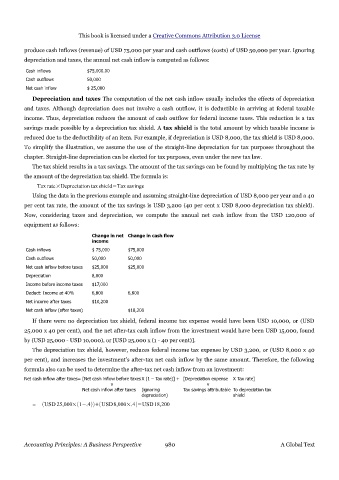Page 979 - Accounting Principles (A Business Perspective)
P. 979
This book is licensed under a Creative Commons Attribution 3.0 License
produce cash inflows (revenue) of USD 75,000 per year and cash outflows (costs) of USD 50,000 per year. Ignoring
depreciation and taxes, the annual net cash inflow is computed as follows:
Cash inflows $75,000.00
Cash outflows 50,000
Net cash inflow $ 25,000
Depreciation and taxes The computation of the net cash inflow usually includes the effects of depreciation
and taxes. Although depreciation does not involve a cash outflow, it is deductible in arriving at federal taxable
income. Thus, depreciation reduces the amount of cash outflow for federal income taxes. This reduction is a tax
savings made possible by a depreciation tax shield. A tax shield is the total amount by which taxable income is
reduced due to the deductibility of an item. For example, if depreciation is USD 8,000, the tax shield is USD 8,000.
To simplify the illustration, we assume the use of the straight-line depreciation for tax purposes throughout the
chapter. Straight-line depreciation can be elected for tax purposes, even under the new tax law.
The tax shield results in a tax savings. The amount of the tax savings can be found by multiplying the tax rate by
the amount of the depreciation tax shield. The formula is:
Tax rate×Depreciation taxshield=Tax savings
Using the data in the previous example and assuming straight-line depreciation of USD 8,000 per year and a 40
per cent tax rate, the amount of the tax savings is USD 3,200 (40 per cent x USD 8,000 depreciation tax shield).
Now, considering taxes and depreciation, we compute the annual net cash inflow from the USD 120,000 of
equipment as follows:
Change in net Change in cash flow
income
Cash inflows $ 75,000 $75,000
Cash outflows 50,000 50,000
Net cash inflow before taxes $25,000 $25,000
Depreciation 8,000
Income before income taxes $17,000
Deduct: Income at 40% 6,800 6,800
Net income after taxes $10,200
Net cash inflow (after taxes) $18,200
If there were no depreciation tax shield, federal income tax expense would have been USD 10,000, or (USD
25,000 x 40 per cent), and the net after-tax cash inflow from the investment would have been USD 15,000, found
by (USD 25,000 - USD 10,000), or [USD 25,000 x (1 - 40 per cent)].
The depreciation tax shield, however, reduces federal income tax expense by USD 3,200, or (USD 8,000 x 40
per cent), and increases the investment's after-tax net cash inflow by the same amount. Therefore, the following
formula also can be used to determine the after-tax net cash inflow from an investment:
Net cash inflow after taxes= [Net cash inflow before taxes X (1 – Tax rate)] + [Depreciation expense X Tax rate]
v v
Net cash inflow after taxes (ignoring Tax savings attributable To depreciation tax
depreciation) shield
= USD 25,000×1−.4USD8,000×.4=USD18,200
Accounting Principles: A Business Perspective 980 A Global Text

